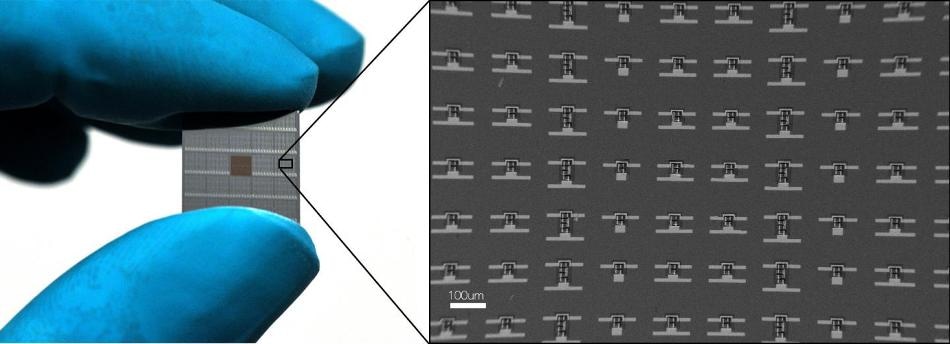Mar 8 2019
Scientists have harnessed the newest nanofabrication methods to develop bug-shaped robots that are wirelessly driven, able to survive challenging environments, able to walk, and small enough to be injected via a standard hypodermic needle.
 Chip pic: Robots are built massively in parallel using nanofabrication technology: each wafer holds 1 million machines. (CREDIT: Marc Mishkin)
Chip pic: Robots are built massively in parallel using nanofabrication technology: each wafer holds 1 million machines. (CREDIT: Marc Mishkin)
"When I was a kid, I remember looking in a microscope, and seeing all this crazy stuff going on. Now we're building stuff that's active at that size. We don't just have to watch this world. You can actually play in it," said Marc Miskin, who formulated the nanofabrication methods with his colleagues professors Itai Cohen and Paul McEuen and researcher Alejandro Cortese at Cornell University while Miskin was a postdoc in the laboratory for atomic and solid state physics there. In January, Miskin became an assistant professor of electrical and systems engineering at the University of Pennsylvania.
The microscopic robot research will be presented by Miskin at the American Physical Society March Meeting in Boston. He will also take part in a press conference explaining the work.
Origins of the Micro Robots
In the past several years, Miskin and research colleagues created a multistep nanofabrication method that converts a four-inch specialized silicon wafer into a million microscopic robots in a matter of weeks. Each 70 micron long (approximately the width of an extremely very thin human hair), the robots’ bodies are built using a superthin rectangular skeleton of glass topped with a thin layer of silicon into which the scientists etch its electronics control parts and either two or four silicon solar cells—the elementary equivalent of organs and a brain.
The really high-level explanation of how we make them is we're taking technology developed by the semiconductor industry and using it to make tiny robots.
Marc Miskin, Assistant professor of Electrical and Systems Engineering, University of Pennsylvania.
Each of a robot’s four legs is built from a bilayer of titanium and platinum (or alternately, graphene). The platinum is laid on using atomic layer deposition. "It's like painting with atoms," said Miskin. The platinum-titanium layer is later cut into four 100-atom-thick legs of each robot.
The legs are super strong. Each robot carries a body that's 1,000 times thicker and weighs roughly 8,000 times more than each leg.
Marc Miskin, Assistant professor of Electrical and Systems Engineering, University of Pennsylvania.
The scientists aim a laser on one of a robot’s solar cells to work it. This makes the platinum in the leg to expand, while the titanium stays rigid in turn, making the limb to bend. The robot’s gait is produced because each solar cell causes the alternate relaxing or contraction of the front or back legs.
The team first saw a robot’s leg move a number of days prior to Christmas 2017. "The leg just twitched a bit," recalled Miskin. "But it was the first proof of concept—this is going to work!"
Researchers at Cornell and Pennsylvania are, at present, working on smart versions of the robots with on-board sensors, controllers, and clocks.
The present laser power source would restrict the robot’s control to a fingernail-width into tissue. Therefore, Miskin is looking for new energy sources, including magnetic fields and ultrasound, that would enable these robots to perform inconceivable journeys in the human body for tasks such as mapping the brain or drug delivery.
We found out you can inject them using a syringe and they survive—they're still intact and functional—which is pretty cool.
Marc Miskin, Assistant professor of Electrical and Systems Engineering, University of Pennsylvania.